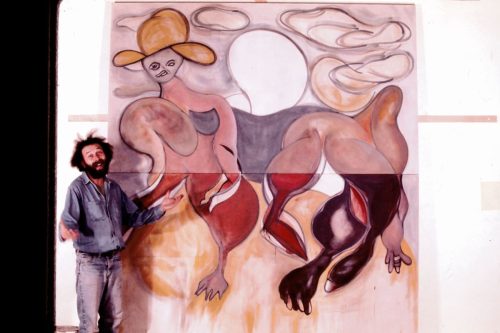
On Basil King’s Art
“His work is meant to be seen before it is judged, just like Van Gogh’s. Or Soutine. Look at it, see what you see. This work speaks its own story because it’s involved with style… Basil’s figures are painted on, they do not emerge through. He’s an illustrator after appearances, illustrating what he wants but we might not want, to see. This work reflects his point of view his way: he’s the artist, not the apologist.
…We don’t know how brainwashed we are until we see original work like this, that reaches in, grabs hold, and gives our senses a good rattle.”
—Fielding Dawson on Basil King’s “Paintings from the Cards”, Granary Gallery, 1989.
“He’s the most genuine, and therefore ultimately important, kind of artist/poet, whose work over many decades is driven by an unquenched actual passion and inner principle we rightly call vision….his prolific and life-embodying work is in no way dependent on the judgment or acceptance or purchase–power of others. It simply has to be, it just goes on, and you can feel that necessity throughout.”
—George Quasha, at the premiere of the film Basil King: MIRAGE at Anthology Film Archives, September 2012.
“”What is the function of repetition in his work, in both writing and painting? He has said that he does not do individual paintings or drawings, that it’s not his manner of working, that he always works serially…Suffice it to say that King is a hybrid figure; he can’t be pinned down to one discipline. To evaluate his work in one area without taking into context the range of his activities, would be to miss an essential fluctuation in our century’s motion.”
—Vincent Katz, “from his essay in Light Abstracts the Smallest Things: The Aesthetics of Basil King, Talisman House, 2020
“The circle calls us—obviously so in King’s paintings of birds or baseball players or in his portraits; the people there in his paintings await our attention. The ground holds them, however, in their utter presence. If we look we might take notice. We are called to that… His visual art is how the ground, unremarked, unremarkable, nevertheless threatens to loom up, while it never does…the canvas’s destabilized figures can only be sustained by some function in the service of the circle.”
—Burt Kimmelman, “from his essay in Light Abstracts the Smallest Things: The Aesthetics of Basil King, Talisman House, 2020
“King’s works on paper share that vital psychic “space” realm or zone, in which intuitions connect to the materialization of the mark at a deeply psychological level. Abstraction embodies contradiction, resistance, union, reconciliation. Zones and presences intermix, and a spectrum of being emerges and develops within pictorial space.”
—Kimberly Lyons, “from her essay in Light Abstracts the Smallest Things: The Aesthetics of Basil King, Talisman House, 2020
